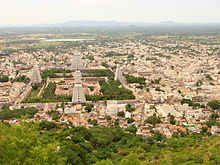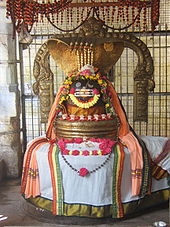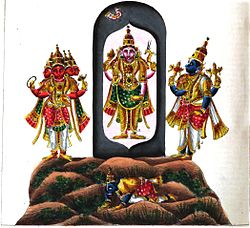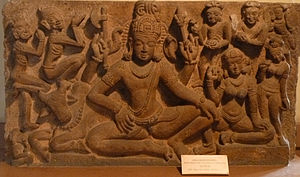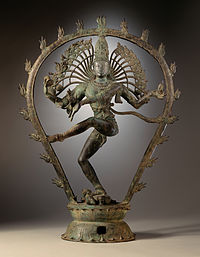|
|
Classification |
| Devanagari | शिव |
| Sanskrit Transliteration | Siva |
| Affiliation | Parameshwara (Supreme God), Trimurti |
| Abode | no_data |
| Mantra | Om Namah Shivaya, Mahamrityunjaya Mantra |
| Weapon | Trishula |
| Consort | Sati, Parvati (also known as Durga, Kali, and Shakti) |
| Children | Kartikeya, Ganesha |
| Mount | Nandi (bull) |
Shiva (Siva, /ˈʃɪvə/listen (help·info) meaning "The Auspicious One"), also known as Mahadeva, Mahesh ("Great God") or Bholenath ("Simple Lord"), is a popular Hindu deity and considered the Supreme God within Shaivism, one of the three most influential denominations in Hinduism. Shiva is regarded as one of the primary forms of God, such as one of the five primary forms of God in the Smarta tradition, and "the Destroyer" or "the Transformer" among the Trimurti, the Hindu Trinity of the primary aspects of the divine. Shiva is also regarded as the patron god of yoga and arts.
Shiva is usually worshipped in the aniconic form of Lingam. Shiva of the highest level is limitless, transcendent, unchanging and formless. However, Shiva also has many benevolent and fearsome forms. In benevolent aspects, he is depicted as an omniscient yogi who lives an ascetic life on Mount Kailash, as well as a householder with wife Parvati and two sons, Ganesha and Kartikeya or as the Cosmic Dancer. In fierce aspects, he is often depicted slaying demons. The most recognizable iconographical attributes of the god are a third eye on his forehead, a snake around his neck, the crescent moon adorning and the river Ganga flowing from his matted hair, the trishula as his weapon and the damaru as his instrument.
Shiva as we know him today shares many features with the Vedic god Rudra. Some historians have also suggested that a Shiva-like deity existed in pre-Vedic times, but not all historians agree on this.
| Shiva |
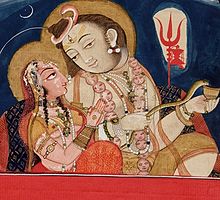
Shiva as a householder with wife Parvati as depicted in an 1820 Rajput painting. |
| Devanagari |
शिव |
| Sanskrit Transliteration |
Siva |
| Tamil Transliteration |
Sivan |
| Affiliation |
Parameshwara (Supreme God), Trimurti |
| Mantra |
Om Namah Shivaya, Mahamrityunjaya Mantra |
| Weapon |
Trishula |
| Consort |
Sati, Parvati (also known as Durga, Kali, and Shakti) |
| Children |
Kartikeya, Ganesha |
| Mount |
Nandi (bull) |
Shiva (meaning "The Auspicious One"), also known as Parameshwara(the Supreme God), Mahadeva, Mahesh ("Great God") or Bholenath ("Simple Lord"), is a popular Hindu deity and considered as the Supreme God within Shaivism, one of the three most influential denominations in Hinduism. Shiva is regarded as one of the primary forms of God, such as one of the five primary forms of God in the Smarta tradition, and "the Destroyer" or "the Transformer" among the Trimurti, the Hindu Trinity of the primary aspects of the divine. Shiva is also regarded as the patron god of yoga and arts.
Shiva is usually worshiped in the aniconic form of Lingam. Shiva of the highest level is limitless, transcendent, unchanging and formless. However, Shiva also has many benevolent and fearsome forms. In benevolent aspects, he is depicted as an omniscient Yogi who lives an ascetic life on Mount Kailash, as well as a householder with wife Parvati and two sons, Ganesha and Kartikeya or as the Cosmic Dancer. In fierce aspects, he is often depicted slaying demons. The most recognizable iconographical attributes of the god are a third eye on his forehead, a snake around his neck, the crescent moon adorning and the river Ganga flowing from his matted hair, the trishula as his weapon and the damaru as his instrument.
Shiva as we know him today shares features with the Vedic god Rudra. Historians have also suggested that worship of Shiva existed in pre-Vedic times, but not all historians agree on this.
Etymology and other names
The Sanskrit word Shiva (Devanagari: शिव, Siva) comes from Shri Rudram Chamakam of Taittiriya Samhita (TS 4.5, 4.7) of Krishna Yajurveda. The root word Si means auspicious. In simple English transliteration it is written either as Shiva or Siva. The adjective Siva, is used as an attributive epithet not particularly of Rudra, but of several other Vedic deities.
The other popular names associated with Shiva are Mahadev, Mahesh, Maheshwar, Shankar, Shambhu, Rudra, Har, Trilochan, Devendra (meaning Chief of the Gods) and Trilokinath (meaning Lord of the three realms).
The Sanskrit word Saiva means "relating to the god Shiva", and this term is the Sanskrit name both for one of the principal sects of Hinduism and for a member of that sect. It is used as an adjective to characterize certain beliefs and practices, such as Shaivism. He is the oldest worshipped Lord of India.
The Tamil word Sivan, Tamil: சிவன் ("Fair Skinned") could have been derived from the word sivappu. The word 'sivappu' means "red" in Tamil language but while addressing a person's skin texture in Tamil the word 'Sivappu' is used for being Fair Skinned.
Adi Sankara, in his interpretation of the name Shiva, the 27th and 600th name of Vishnu sahasranama, the thousand names of Vishnu interprets Shiva to have multiple meanings: "The Pure One", or "the One who is not affected by three Gunas of Prakrti (Sattva, Rajas, and Tamas)" or "the One who purifies everyone by the very utterance of His name." Swami Chinmayananda, in his translation of Vishnu sahasranama, further elaborates on that verse: Shiva means "the One who is eternally pure" or "the One who can never have any contamination of the imperfection of Rajas and Tamas".
Shiva's role as the primary deity of Shaivism is reflected in his epithets Mahadeva ("Great God"; Maha "Great" and deva "god"), MaheSvara ("Great Lord"; Maha "great" and iSvara "lord"), and ParameSvara ("Supreme Lord").
There are at least eight different versions of the Shiva Sahasranama, devotional hymns (stotras) listing many names of Shiva. The version appearing in Book 13 (AnuSasanaparvan) of the Mahabharata is considered the kernel of this tradition. Shiva also has Dasha-Sahasranamas (10,000 names) that are found in the Mahanyasa. The Shri Rudram Chamakam, also known as the Satarudriya, is a devotional hymn to Shiva hailing him by many names.
Historical development and literature
The worship of Shiva is a pan-Hindu tradition, practiced widely across all of India, Nepal and Sri Lanka. Some historians believe that the figure of Shiva as we know him today was built up over time, with the ideas of many regional sects being amalgamated into a single figure. How the persona of Shiva converged as a composite deity is not well documented. Axel Michaels the Indologist suggests Shaivism like Vaishnavism, implies a unity which cannot be clearly found either in religious practice or in philosophical and esoteric doctrine. Furthermore, practice and doctrine must be kept separate.
An example of assimilation took place in Maharashtra, where a regional deity named Khandoba is a patron deity of farming and herding castes. The foremost center of worship of Khandoba in Maharashtra is in Jejuri. Khandoba has been assimilated as a form of Shiva himself, in which case he is worshipped in the form of a lingam. Khandoba's varied associations also include an identification with Surya and Karttikeya.
The Pashupati seal
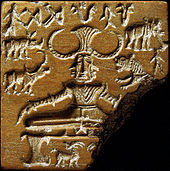
Seal discovered during excavation of the Mohenjodaro archaeological site in the Indus Valley has drawn attention as a possible representation of a "yogi" or "proto-Shiva" figure
Many Indus valley seals show animals. One seal that has attracted attention shows a figure, either horned or wearing a horned headdress and possibly ithyphallic figure seated in a posture reminiscent of the Lotus position and surrounded by animals was named by early excavators of Mohenjo-daro Pashupati (lord of cattle), an epithet of the later Hindu gods Shiva and Rudra. Sir John Marshal and others have claimed that this figure is a prototype of Shiva and have described the figure as having three faces seated in a "yoga posture" with the knees out and feet joined. However, this claim is not without its share of critics, with some academics like Gavin Flood and John Keay characterizing them as unfounded.
Writing in 1997 Doris Srinivasan said that "Not too many recent studies continue to call the seal's figure a "Proto-Siva," rejecting thereby Marshall's package of proto-Siva features, including that of three heads. She interprets what John Marshall interpreted as facial as not human but more bovine, possibly a divine buffalo-man. According to Iravatham Mahadevan symbols 47 and 48 of his Indus script glossary The Indus Script: Texts, Concordance and Tables (1977), representing seated human-like figures, could describe Hindu deity Murugan.
According to Rita P. Wright:
Several lines of evidence have been used to identify depictions of gods, goddesses , and animals as symbols of practices known from historic South Asian religions, principally Buddhism and Hinduism. The figurines and narratives depicted on seals continue to be central to arguments for and against these interpretations. Their direct relationship to modern South Asian religions remains ambiguous in view of the great time depth between the last vestiges of the Indus civilization and the emergence of Hinduism and Buddhism in the mid to late first millennium B. C. Even if later religions were to have borrowed and/or revived imagery from the Indus culture, the meanings attached to them are unlikely to have remained the same, since meanings inherent in borrowed images typically are transformed in a new cultural context.
There are no religious buildings or evidence of elaborate burials. If there were temples, they have not been identified. However, House - 1 in HR-A area in Mohenjadaro's Lower Town has been identified as a possible temple.
In the Vedas
Shiva's rise to a major position in the pantheon was facilitated by his identification with a host of Vedic deities, including Rudra, Agni, Indra, Prajapati, Vayu, and others.
Rudra
Main article: Rudra
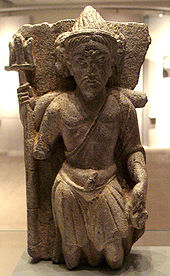
Three-headed Shiva, Gandhara, 2nd century C.E.
Shiva as we know him today shares many features with the Vedic god Rudra, and both Shiva and Rudra are viewed as the same personality in Hindu scriptures. The two names are used synonymously. Rudra, the god of the roaring storm, is usually portrayed in accordance with the element he represents as a fierce, destructive deity.
The oldest surviving text of Hinduism is the Rig Veda, which is dated to between 1700 and 1100 BC based on linguistic and philological evidence. A god named Rudra is mentioned in the Rig Veda. The name Rudra is still used as a name for Shiva. In RV 2.33, he is described as the "Father of the Rudras", a group of storm gods. Furthermore, the Rudram, one of the most sacred hymns of Hinduism found both in the Rig and the Yajur Vedas and addressed to Rudra, invokes him as Shiva in several instances, but the term Shiva is used as an epithet for the gods Indra, Mitra and Agni many times. Since Shiva means pure, the epithet is possibly used to describe a quality of these gods rather than to identify any of them with the God Shiva.
The identification of Shiva with the older god Rudra is not universally accepted, as Axel Michaels explains:
Rudra is called "The Archer" (Sanskrit: Sarva), and the arrow is an essential attribute of Rudra. This name appears in the Shiva Sahasranama, and R. K. Sharma notes that it is used as a name of Shiva often in later languages.
The word is derived from the Sanskrit root Sarv-, which means "to injure" or "to kill", and Sharma uses that general sense in his interpretive translation of the name Sarva as "One who can kill the forces of darkness". The names Dhanvin ("Bowman") and Banahasta ("Archer", literally "Armed with arrows in his hands") also refer to archery.
Agni
Rudra and Agni have a close relationship. The identification between Agni and Rudra in the Vedic literature was an important factor in the process of Rudra's gradual development into the later character as Rudra-Shiva. The identification of Agni with Rudra is explicitly noted in the Nirukta, an important early text on etymology, which says, "Agni is also called Rudra." The interconnections between the two deities are complex, and according to Stella Kramrisch:
The fire myth of Rudra-Siva plays on the whole gamut of fire, valuing all its potentialities and phases, from conflagration to illumination.
In the Satarudriya, some epithets of Rudra, such as Sasipañjara ("Of golden red hue as of flame") and Tivashimati ("Flaming bright"), suggest a fusing of the two deities. Agni is said to be a bull, and Lord Shiva possesses a bull as his vehicle, Nandi. The horns of Agni, who is sometimes characterized as a bull, are mentioned. In medieval sculpture, both Agni and the form of Shiva known as Bhairava have flaming hair as a special feature.
Indra
According to a theory, the Puranic Shiva is a continuation of the Vedic Indra. He gives several reasons for his hypothesis. Both Shiva and Indra are known for having a thirst for Soma. Both are associated with mountains, rivers, male fertility, fierceness, fearlessness, warfare, transgression of established mores, the Aum sound, the Supreme Self. In the Rig Veda the term Siva is used to refer to Indra. (2.20.3, 6.45.17, and 8.93.3.) Indra, like Shiva, is likened to a bull. In the Rig Veda, Rudra is the father of the Maruts, but he is never associated with their warlike exploits as is Indra.
Later Vedic literature
Rudra's transformation from an ambiguously characterized deity to a supreme being began in the Shvetashvatara Upanishad (400-200 BCE), which founded the tradition of Rudra-Shiva worship. Here they are identified as the creators of the cosmos and liberators of souls from the birth-rebirth cycle. The period of 200 BCE to 100 CE also marks the beginning of the Shaiva tradition focused on the worship of Shiva, with references to Shaiva ascetics in Patanjali's Mahabhasya and in the Mahabharata.
Early historical paintings at the Bhimbetka rock shelters, depict Shiva dancing, Shiva's trident, and his mount Nandi but no other Vedic gods.
Puranic literature
The Shiva Puranas, particularly the Shiva Purana and the Linga Purana, discuss the various forms of Shiva and the cosmology associated with him.
Tantric literature
The Tantras, composed between the 8th and 11th centuries, regard themselves as Sruti. Among these the Shaiva Agamas, are said to have been revealed by Shiva himself and are foundational texts for Shaiva Siddhanta.
Position within Hinduism
Shaivism
Shaivism (Sanskrit: शैव पंथ, Saiva paṁtha) (Tamil: சைவ சமயம்) is the oldest of the four major sects of Hinduism, the others being Vaishnavism, Shaktism and Smartism. Followers of Shaivism, called "Shaivas", and also "Saivas" or "Saivites", revere Shiva as the Supreme Being. Shaivas believe that Shiva is All and in all, the creator, preserver, destroyer, revealer and concealer of all that is. The tantric Shaiva tradition consists of the Kapalikas, Kashmir Shaivism and Shaiva Siddhanta. The Shiva MahaPurana is one of the puranas, a genre of Hindu religious texts, dedicated to Shiva. Shaivism is widespread throughout India, Nepal, and Sri Lanka, mostly. Areas notable for the practice of Shaivism include parts of Southeast Asia, especially Malaysia, Singapore, and Indonesia.
Panchayatana puja
Panchayatana puja is the system of worship ('puja') in the Smarta sampradaya of Hinduism. It is said to have been introduced by Adi Shankara, the 8th century CE Hindu philosopher. It consists of the worship of five deities: Shiva, Vishnu, Devi, Surya and Ganesha. Depending on the tradition followed by Smarta households, one of these deities is kept in the center and the other four surround it. Worship is offered to all the deities. The five are represented by small murtis, or by five kinds of stones, or by five marks drawn on the floor.
Trimurti
Main article: Trimurti
The Trimurti is a concept in Hinduism
in which the cosmic functions of creation, maintenance, and destruction are personified by the forms of Brahma the creator, Vishnu the maintainer or preserver and Shiva the destroyer or transformer,"
These three deities have been called "the Hindu triad" or the "Great Trinity", often addressed as "Brahma-Vishnu-Maheshwara."
Iconography and properties
Attributes
![]()
Shiva with Parvati. Shiva is depicted three-eyed, the Ganges flowing through his matted hair, wearing ornaments of serpents and a skull bracelet, and covered in ashes, and seated on a tiger skin.
- Shiva's form: Shiva has a Trident in the right lower arm, with a crescent moon on his head. He is said to be fair like camphor or like an ice clad mountain. He has fire and Damaru and Mala or a kind of weapon. He wears five serpents as ornaments. He wears a garland of skulls. He is pressing with his feet the demon Muyalaka, a dwarf holding a cobra. He faces south. Panchakshara itself is his body. (The trident, like almost all other forms in Hinduism, can be understood as the symbolism of the unity of three worlds that a human faces - his inside world, his immediate world, and the broader overall world. At the base of the trident, all three forks unite.)
- Third eye: (Trilochana) Shiva is often depicted with a third eye, with which he burned Desire (Kama) to ashes, called "Tryambakam" (Sanskrit: त्र्यम्बकम् ), which occurs in many scriptural sources. In classical Sanskrit, the word ambaka denotes "an eye", and in the Mahabharata, Shiva is depicted as three-eyed, so this name is sometimes translated as "having three eyes". However, in Vedic Sanskrit, the word amba or ambika means "mother", and this early meaning of the word is the basis for the translation "three mothers". These three mother-goddesses who are collectively called the Ambikas. Other related translations have been based on the idea that the name actually refers to the oblations given to Rudra, which according to some traditions were shared with the goddess Ambika. It has been mentioned that when Shiva loses his temper badly, his third eye opens which can destroy most of the things to ashes.
- Crescent moon: (The epithets "Chandrasekhara/Chandramouli")- Shiva bears on his head the crescent moon. The epithet CandraSekhara (Sanskrit: चन्द्रशेखर "Having the moon as his crest" - candra = "moon"; Sekhara = "crest, crown") refers to this feature. The placement of the moon on his head as a standard iconographic feature dates to the period when Rudra rose to prominence and became the major deity Rudra-Shiva. The origin of this linkage may be due to the identification of the moon with Soma, and there is a hymn in the Rig Veda where Soma and Rudra are jointly implored, and in later literature, Soma and Rudra came to be identified with one another, as were Soma and the moon. The crescent moon is shown on the side of the Lord's head as an ornament. The waxing and waning phenomenon of the moon symbolizes the time cycle through which creation evolves from the beginning to the end. Since the Lord is the Eternal Reality, He is beyond time. Thus, the crescent moon is only one of His ornaments. The wearing of the crescent moon in his head indicates that He has controlled the mind perfectly.
- Ashes: (The epithet "Bhasmaanga Raaga") - Shiva smears his body with ashes (bhasma). Ashes represent the final reality that a human being will face - the end of all material existence. Some forms of Shiva, such as Bhairava, are associated with a very old Indian tradition of cremation-ground asceticism that was practiced by some groups who were outside the fold of brahmanic orthodoxy. These practices associated with cremation grounds are also mentioned in the Pali canon of Theravada Buddhism. One epithet for Shiva is "inhabitant of the cremation ground" (Sanskrit: SmaSanavasin, also spelled Shmashanavasin), referring to this connection. It is interesting to see the peaceful acceptance of cremation ground temples of Batuk Bhairava, a form of Lord Shiva, by the general populace. At Ujjain, near the Kaal Bhairava temple lies such a cremation ground temple of Batuk Bhairava, with its legendary disciple Baba Dabral known throughout Central India (as he is blessed, people say, with the ability to literally read out incidents of the future in one's life just by holding one's palm).
- Matted hair: (The epithet "Jataajoota Dhari/Kapardina") - Shiva's distinctive hair style is noted in the epithets Jatin, "the one with matted hair", and Kapardin, "endowed with matted hair" or "wearing his hair wound in a braid in a shell-like (kaparda) fashion". A kaparda is a cowrie shell, or a braid of hair in the form of a shell, or, more generally, hair that is shaggy or curly. His hair is said to be like molten gold in color or being yellowish-white.
- Blue throat: The epithet Nilakantha (Sanskrit नीलकण्ठ; nila = "blue", kantha = "throat") since Shiva drank the Halahala poison churned up from the Samudra Manthan to eliminate its destructive capacity. Shocked by his act, Goddess Parvati strangled his neck and hence managed to stop it in his neck itself and prevent it from spreading all over the universe supposed to be in Shiva's stomach. However the poison was so potent that it changed the color of his neck to blue.[122] (See Maha Shivaratri.)
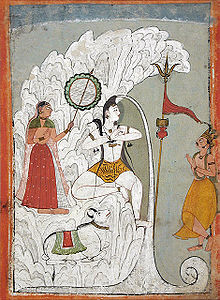
Shiva bearing the descent of the Ganges River as Parvati and Bhagiratha and the bull Nandi look, folio from a Hindi manuscript by the Narayan, circa 1740
- Sacred Ganges: (The epithet "Gangadhara") Bearer of Ganga. Ganges river flows from the matted hair of Shiva.[123][124] The Gaṅga (Ganges), one of the major rivers of the country, is said to have made her abode in Shiva's hair.[125] The flow of the Ganges also represents the nectar of immortality.
- Tiger skin: (The epithet "Krittivasana").He is often shown seated upon a tiger skin, an honour reserved for the most accomplished of Hindu ascetics, the Brahmarishis.[126] Tiger represents lust. His sitting on the tiger's skin indicates that He has conquered lust.
- Serpents: (The epithet "Nagendra Haara"). Shiva is often shown garlanded with a snake.[127] His wearing of serpents on the neck denotes wisdom and eternity.
- Deer: His holding deer on one hand indicates that He has removed the Chanchalata of the mind (i.e., attained maturity and firmness in thought process). Deer jump from one place to another swiftly, similar to the mind moving from one thought to another.
- Trident: (Sanskrit: Trishula): Shiva's particular weapon is the trident. His Trisul that is held in His right hand represents the three Gunas—Sattva, Rajas and Tamas. That is the emblem of sovereignty. He rules the world through these three Gunas. The Damaru in His left hand represents the Sabda Brahman. It represents OM from which all languages are formed. It is He who formed the Sanskrit language out of the Damaru sound.
- Drum: A small drum shaped like an hourglass is known as a damaru (Sanskrit: ḍamaru).[128][129] This is one of the attributes of Shiva in his famous dancing representation[130] known as Nataraja. A specific hand gesture (mudra) called ḍamaru-hasta (Sanskrit for "ḍamaru-hand") is used to hold the drum.[131] This drum is particularly used as an emblem by members of the Kapalika sect.[132]
- Axe: (Sanskrit: Parashu):The parashu is the weapon of Lord Shiva who gave it to Parashurama, sixth Avatar of Vishnu, whose name means "Rama with the axe" and also taught him its mastery.
- Nandi: (The epithet "Nandi Vaahana").Nandi, also known as Nandin, is the name of the bull that serves as Shiva's mount (Sanskrit: vahana).[133][134] Shiva's association with cattle is reflected in his name PaSupati, or Pashupati (Sanskrit: पशुपति), translated by Sharma as "lord of cattle"[135] and by Kramrisch as "lord of animals", who notes that it is particularly used as an epithet of Rudra.[136] Rishabha or the bull represents Dharma Devata. Lord Siva rides on the bull. Bull is his vehicle. This denotes that Lord Siva is the protector of Dharma, is an embodiment of Dharma or righteousness.
- Gana: The Ganas (Devanagari: गण) are attendants of Shiva and live in Kailash. They are often referred to as the bhutaganas, or ghostly hosts, on account of their nature. Generally benign, except when their lord is transgressed against, they are often invoked to intercede with the lord on behalf of the devotee. Ganesha was chosen as their leader by Shiva, hence Ganesha's title gana-iSa or gana-pati, "lord of the ganas".[137]
- Mount Kailasa: Mount Kailash in the Himalayas is his traditional abode. In Hindu mythology, Mount Kailasa is conceived as resembling a Linga, representing the center of the universe.[138]
- Varanasi: Varanasi (Benares) is considered to be the city specially loved by Shiva, and is one of the holiest places of pilgrimage in India. It is referred to, in religious contexts, as Kashi.[139]
Lingam
Apart from anthropomorphic images of Shiva, the worship of Shiva in the form of a lingam, or linga, is also important.[140][141][142] These are depicted in various forms. One common form is the shape of a vertical rounded column. Shiva means auspiciousness, and linga means a sign or a symbol. Hence, the Shivalinga is regarded as a "symbol of the great God of the universe who is all-auspiciousness".[143] Shiva also means "one in whom the whole creation sleeps after dissolution".[143] Linga also means the same thing—a place where created objects get dissolved during the disintegration of the created universe. Since, according to Hinduism, it is the same god that creates, sustains and withdraws the universe, the Shivalinga represents symbolically God Himself.[143] Some scholars, such as Monier-Williams and Wendy Doniger, also view linga as a phallic symbol,[144][145] although this interpretation is disputed by others, including Christopher Isherwood,[146] Vivekananda,[147] Swami Sivananda,[148] and S.N. Balagangadhara.[149]
Jyotir Linga
The worship of Shiva or Rudra can be dated back to the primitive worship of The Almighty. The people in these period used to worship the natural forces and represented The Almighty in the stones. The Linga worship could be a primitive form of idol worship. Gradually the culture may have been assimilated to the Ancient Aryan-Dravidian culture and there by to the Sanskrit literature.
The worship of the Shiva-Linga originated from the famous hymn in the Atharva-Veda Samhitâ sung in praise of the Yupa-Stambha, the sacrificial post. In that hymn, a description is found of the beginningless and endless Stambha or Skambha, and it is shown that the said Skambha is put in place of the eternal Brahman. Just as the Yajna (sacrificial) fire, its smoke, ashes, and flames, the Soma plant, and the ox that used to carry on its back the wood for the Vedic sacrifice gave place to the conceptions of the brightness of Shiva's body, his tawny matted hair, his blue throat, and the riding on the bull of the Shiva, the Yupa-Skambha gave place in time to the Shiva-Linga.[150][151] In the text Linga Purana, the same hymn is expanded in the shape of stories, meant to establish the glory of the great Stambha and the superiority of Shiva as Mahadeva.[151]
The sacred of all Shiva linga is worshipped as Jyotir linga. Jyoti means Radiance, apart from relating Shiva linga as a phallus symbol, there are also arguments that Shiva linga means 'mark' or a 'sign'. The way of worship of primitive men by representing The Almighty on a stone. Jyotirlinga means The Radiant sign of The Almighty. The Jyotirlingas are mentioned in Shiva Purana.[152] The dwadasha (12) Jyotirlinga's are told in Dwadasha Jyotirlinga stotram Sanskrit Literature as
Sanskrit: :सौराष्ट्रे सोमनाथं च श्रीशैले मल्लिकार्जुनम्। उज्जयिन्यां महाकालमोङ्कारममलेश्वरम्॥
- परल्यां वैद्यनाथं च डाकिन्यां भीमशङ्करम्। सेतुबन्धे तु रामेशं नागेशं दारुकावने॥
- वाराणस्यां तु विश्वेशं त्र्यम्बकं गौतमीतटे। हिमालये तु केदारं घुश्मेशं च शिवालये॥
- एतानि ज्योतिर्लिङ्गानि सायं प्रातः पठेन्नरः। सप्तजन्मकृतं पापं स्मरणेन विनश्यति॥
- एतेशां दर्शनादेव पातकं नैव तिष्ठति। कर्मक्षयो भवेत्तस्य यस्य तुष्टो महेश्वराः॥
English Translation: Somanatham in Saurashtra and Mallikarjunam in Shri-Shail. (सौराष्ट्रे सोमनाथं च श्रीशैले मल्लिकार्जुनम्); Mahakaal in Ujjain and Amleshwar in Omkareshwar. (उज्जयिन्यां महाकालमोङ्कारममलेश्वरम्); Vaidyanath in Paralya and Bhimashankaram in Dakniya. (परल्यां वैद्यनाथं च डाकिन्यां भीमशङ्करम्);Rameshem (Rameshwaram) in Sethubandh and Nageshem (Nageshwar) in Darauka-Vana. (सेतुबन्धे तु रामेशं नागेशं दारुकावने);Vishwa-Isham (Vishvanath) in Vanarasi and Triambakam at bank of Gautami River. (वाराणस्यां तु विश्वेशं त्र्यम्बकं गौतमीतटे));Kedar (Kedarnath) in Himalayas and Gushmesh (Gushmeshwar) in Shivalaya (Shiwar). (। हिमालये तु केदारं घुश्मेशं च शिवालये) [152]
Shakti
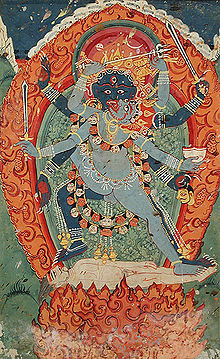
Kali and Bhairava (the terrible form of Shiva) in Union, 18th century, Nepal
Main article: Shakti
Shiva forms a Tantric couple with Shakti, the embodiment of energy, dynamism, and the motivating force behind all action and existence in the material universe. Shiva is her transcendent masculine aspect, providing the divine ground of all being. Shakti manifests in several female deities. Sati and Parvati are the main consorts of Shiva, but she is also manifested as Uma, Durga (Parvata), Kali[153] and Chandika. Kali is the manifestation of Shakti in her dreadful aspect. The name Kali comes from kala, which means black, time, death, lord of death, Shiva. Since Shiva is called Kala, the eternal time, Kali, his consort, also means "Time" or "Death" (as in "time has come"). Various Shakta Hindu cosmologies, as well as Shakta Tantric beliefs, worship her as the ultimate reality or Brahman. She is also revered as Bhavatarini (literally "redeemer of the universe"). Kali is represented as the consort of Lord Shiva, on whose body she is often seen standing or dancing. Shiva is the masculine force, the power of peace, while Shakti translates to power, and is considered as the feminine force. In the Vaishnava tradition, these realities are portrayed as Vishnu and Laxmi, or Radha and Krishna. These are differences in formulation rather than a fundamental difference in the principles. Both Shiva and Shakti have various forms. Shiva has forms like Yogi Raj (the common image of Himself meditating in the Himalayas), Rudra (a wrathful form) and Natarajar (Shiva's dance are the Lasya - the gentle form of dance, associated with the creation of the world, and the Tandava - the violent and dangerous dance, associated with the destruction of weary worldviews – weary perspectives and lifestyles).
The five mantra
Five is a sacred number for Shiva.[155] One of his most important mantra has five syllables (namaḥ Sivaya).[156]
Shiva's body is said to consist of five mantra, called the pañcabrahmans.[157] As forms of God, each of these have their own names and distinct iconography:[158]
These are represented as the five faces of Shiva and are associated in various texts with the five elements, the five senses, the five organs of perception, and the five organs of action.[159][160] Doctrinal differences and, possibly, errors in transmission, have resulted in some differences between texts in details of how these five forms are linked with various attributes.[161] The overall meaning of these associations is summarized by Stella Kramrisch:
Through these transcendent categories, Siva, the ultimate reality, becomes the efficient and material cause of all that exists.[162]
According to the Pañcabrahma Upanishad:
One should know all things of the phenomenal world as of a fivefold character, for the reason that the eternal verity of Siva is of the character of the fivefold Brahman. (Pañcabrahma Upanishad 31)[163]
Forms and roles
According to Gavin Flood, "Shiva is a god of ambiguity and paradox," whose attributes include opposing themes.[164] The ambivalent nature of this deity is apparent in some of his names and the stories told about him.
Destroyer and Benefactor
In the Yajurveda, two contrary sets of attributes for both malignant or terrific (Sanskrit: rudra) and benign or auspicious (Sanskrit: Siva) forms can be found, leading Chakravarti to conclude that "all the basic elements which created the complex Rudra-Siva sect of later ages are to be found here".[165] In the Mahabharata, Shiva is depicted as "the standard of invincibility, might, and terror", as well as a figure of honor, delight, and brilliance.[166] The duality of Shiva's fearful and auspicious attributes appears in contrasted names.
The name Rudra (Sanskrit: रुद्र) reflects his fearsome aspects. According to traditional etymologies, the Sanskrit name Rudra is derived from the root rud-, which means "to cry, howl".[167] Stella Kramrisch notes a different etymology connected with the adjectival form raudra, which means "wild, of rudra nature", and translates the name Rudra as "the wild one" or "the fierce god".[168] R. K. Sharma follows this alternate etymology and translates the name as "terrible".[169] Hara (Sanskrit: हर) is an important name that occurs three times in the Anushasanaparvan version of the Shiva sahasranama, where it is translated in different ways each time it occurs, following a commentorial tradition of not repeating an interpretation. Sharma translates the three as "one who captivates", "one who consolidates", and "one who destroys".[170] Kramrisch translates it as "the ravisher".[122] Another of Shiva's fearsome forms is as Kala (Sanskrit: काल), "time", and as Mahakala (Sanskrit: महाकाल), "great time", which ultimately destroys all things.[171][172][173] Bhairava (Sanskrit: भैरव), "terrible" or "frightful",[174] is a fierce form associated with annihilation.[175]
In contrast, the name Sankara (Sanskrit: शङ्कर), "beneficent" or "conferring happiness"[176] reflects his benign form. This name was adopted by the great Vedanta philosopher Sankara (c. 788 - 820 CE), who is also known as Shankaracharya.[177][178] The name Sambhu (Sanskrit: शम्भु), "causing happiness", also reflects this benign aspect.[179][180]
Ascetic and Householder
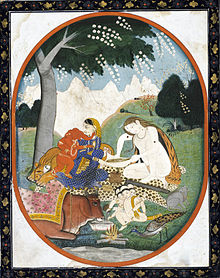
An illustration of the family of Shiva, consisting of Shiva, Parvati, Ganesha and Skanda (Kartikeya)
He is depicted as both an ascetic yogi and as a householder, roles which have been traditionally mutually exclusive in Hindu society.[181] When depicted as a yogi, he may be shown sitting and meditating.[182] His epithet Mahayogi ("the great Yogi: Maha = "great", Yogi = "one who practices Yoga") refers to his association with yoga.[183] While Vedic religion was conceived mainly in terms of sacrifice, it was during the Epic period that the concepts of tapas, yoga, and asceticism became more important, and the depiction of Shiva as an ascetic sitting in philosophical isolation reflects these later concepts.[184] Shiva is also depicted as a corpse below Goddess Kali, it represents that Shiva is a corpse without Shakti. He remains inert. While Shiva is the static form. Mahakali or Shakti is the dynamic aspect without whom Shiva is powerless.
As a family man and householder, he has a wife, Parvati and two sons, Ganesha and Kartikeya. His epithet Umapati ("The husband of Uma") refers to this idea, and Sharma notes that two other variants of this name that mean the same thing, Umakanta and Umadhava, also appear in the sahasranama.[185] Uma in epic literature is known by many names, including the benign Parvati.[186][187] She is identified with Devi, the Divine Mother; Shakti (divine energy) as well as goddesses like Tripura Sundari, Durga, Kamakshi and Meenakshi. The consorts of Shiva are the source of his creative energy. They represent the dynamic extension of Shiva onto this universe.[188] His son Ganesha is worshipped throughout India and Nepal as the Remover of Obstacles, Lord of Beginnings and Lord of Obstacles. Kartikeya is worshipped in Southern India (especially in Tamil Nadu, Kerala and Karnataka) by the names Subrahmanya, Subrahmanyan, Shanmughan, Swaminathan and Murugan, and in Northern India by the names Skanda, Kumara, or Karttikeya.[189]
The depiction of Shiva as Nataraja (Tamil: நடராஜா,Kannada: ನಟರಾಜ, Telugu: నటరాజు, Sanskrit: nataraja, "Lord of Dance") is popular.[190][191] The names Nartaka ("dancer") and Nityanarta ("eternal dancer") appear in the Shiva Sahasranama.[192] His association with dance and also with music is prominent in the Puranic period.[193] In addition to the specific iconographic form known as Nataraja, various other types of dancing forms (Sanskrit: nṛtyamūrti) are found in all parts of India, with many well-defined varieties in Tamil Nadu in particular.[194] The two most common forms of the dance are the Tandava, which later came to denote the powerful and masculine dance as Kala-Mahakala associated with the destruction of the world. When it requires the world or universe to be destroyed, Lord Siva does it by the tanḍavanṛtya.[195][196] and Lasya, which is graceful and delicate and expresses emotions on a gentle level and is considered the feminine dance attributed to the goddess Parvati.[197][198] Lasya is regarded as the female counterpart of Tandava.[198] The Tandava-Lasya dances are associated with the destruction-creation of the world.[199][200][201]
Dakshinamurthy
Main article: DakshinamurthyDakshinamurthy, or Dakshinamūrti (Tamil:தட்சிணாமூர்த்தி, Telugu: దక్షిణామూర్తి, Sanskrit: दक्षिणामूर्ति),[202] literally describes a form (mūrti) of Shiva facing south (dakshina). This form represents Shiva in his aspect as a teacher of yoga, music, and wisdom and giving exposition on the shastras.[203] This iconographic form for depicting Shiva in Indian art is mostly from Tamil Nadu.[204] Elements of this motif can include Shiva seated upon a deer-throne and surrounded by sages who are receiving his instruction.[205]
Ardhanarishvara
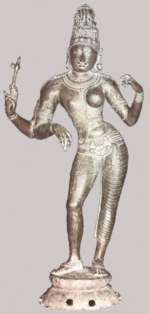
Chola bronze from the 11th century. Shiva in the form of Ardhanarisvara.
An iconographic representation of Shiva called (ArdhanariSvara) shows him with one half of the body as male and the other half as female. According to Ellen Goldberg, the traditional Sanskrit name for this form (ArdhanariSvara) is best translated as "the lord who is half woman", not as "half-man, half-woman".[206] According to legend, Lord Shiva is pleased by the difficult austerites performed by the Goddess Parvati, grants her the left half of his body. This form of Shiva is quite similar to the Yin-Yang philosophy of Eastern Asia, though ArdhanariSvara appears to be more ancient.
Tripurantaka
Shiva is often depicted as an archer in the act of destroying the triple fortresses, Tripura, of the Asuras.[207] Shiva's name Tripurantaka (Sanskrit: त्रिपुरान्तक, Tripurantaka), "ender of Tripura", refers to this important story.[208] In this aspect, Shiva is depicted with four arms wielding a bow and arrow, but different from the Pinakapani murti. He holds an axe and a deer on the upper pair of his arms. In the lower pair of the arms, he holds a bow and an arrow respectively. After destroying Tripura, Tripurantaka Shiva smeared his forehead with three strokes of Ashes. This has become a prominent symbol of Shiva and is practiced even today by Shaivites.
Other forms, avatars, identifications
Shiva, like some other Hindu deities, is said to have several incarnations, known as Avatars. Although Puranic scriptures contain occasional references to "ansh" avatars of Shiva, the idea is not universally accepted in Saivism.[209] The Linga Purana speaks of twenty-eight forms of Shiva which are sometimes seen as avatars.[210] According to the Svetasvatara Upanishad, he has four avatars.[211]
In the Hanuman Chalisa, Hanuman is identified as the eleventh avatar of Shiva and this belief is universal. Hanuman is popularly known as “Rudraavtaar” “Rudra” being a name of “Shiva”.[212] Rama– the Vishnu avatar is considered by some to be the eleventh avatar of Rudra (Shiva).[213][214]
Other traditions regard the sage Durvasa,[217][218] the sage Agastya, the philosopher Adi Shankara, as avatars of Shiva. Other forms of Shiva include Virabhadra and Sharabha.
Relationship with Vishnu
During the Vedic period, both Vishnu and Shiva (as identified with Rudra) played relatively minor roles, but by the time of the Brahmanas (c. 1000 - 700 BC), both were gaining ascendance.[219] By the Puranic period, both deities had major sects that competed with one another for devotees.[220] Many stories developed showing different types of relationships between these two important deities.
Sectarian groups each presented their own preferred deity as supreme. Vishnu in his myths "becomes" Shiva.[221] The Vishnu Purana (4th century C.E.) shows Vishnu awakening and becoming both Brahma to create the world and Shiva to destroy it.[222] Shiva also is viewed as a manifestation of Vishnu in the Bhagavata Purana.[223] In Shaivite myths, on the other hand, Shiva comes to the fore and acts independently and alone to create, preserve, destroy, hide, and to bless (five works).[224] In one Shaivite myth of the origin of the lingam, both Vishnu and Brahma are revealed as emanations from Shiva's manifestation as a towering pillar of flame.[225] The Satarudriya, a Shaivite hymn, says that Shiva is "of the form of Vishnu".[226] Differences in viewpoints between the two sects are apparent in the story of Sarabha (also spelled "Sharabha"), the name of Shiva's incarnation in the composite form of man, bird, and beast. Shiva assumed that unusual form of Sarabheshwara to chastise Vishnu, who in his hybrid form as Narasimha, the man-lion, killed Hiranyakashipu.[227][228] However, Vaishnava followers including Dvaita scholars, such as Vijayindra Tirtha (1539–95) dispute this view of Narasimha based on their reading of Sattvika Puranas and Sruti texts.[229]
According to Mahabharata, a Vaishnav text, Lord Krishna, an incarnation of Lord Vishnu, is one of the greatest devotees of Lord Shiva. In Mahabharata, Anushasana Parva, i.e., In Book 13, Chapter 15 verses 1 to 51, Lord Krishna explains to Yudistira how he got initiated into Pashupata Diksha and how he obtained the grace of Lord Shiva. About soliciting boons of Lord Shiva, Lord Krishna says, "Bowing my head with great joy unto that mass of energy and effulgence (meaning Lord Shiva)...". He calls Lord Shiva Brahman, Parameshwar (the Supreme God) and Paramatman (the Supreme Soul).[230]
Syncretic forces produced stories in which the two deities were shown in cooperative relationships and combined forms. Harihara is the name of a combined deity form of both Vishnu (Hari) and Shiva (Hara).[231] This dual form, which is also called Harirudra, is mentioned in the Mahabharata.[232] An example of a collaboration story is one given to explain Shiva's epithet MahabaleSvara, "lord of great strength" (Maha = "great", Bala = "strength", iSvara = "lord"). This name refers to a story in which Ravana was given a linga as a boon by Shiva on the condition that he carry it always. During his travels, he stopped near the present Gokarna, India in Karnataka to purify himself and asked Ganesha, a son of Parvathi in the guise of a young Brahmin, to hold the linga for him, but after some time, Ganesha put it down on the ground and vanished. When Ravana returned, he could not move the linga, and it is said to remain there ever since.[233]
As one story goes, Shiva is enticed by the beauty and charm of Mohini, Vishnu's female avatar, and procreates with her. As a result of this union, Shasta - identified with regional deities Ayyappa and Ayyanar - is born.[234][235][236][237]
Festivals
Maha Shivaratri
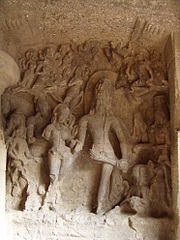
Celestial Marriage of Shiva and Parvati in presence of all depicted at Elephanta Caves
Maha Shivratri is a festival celebrated every year on the 13th night or the 14th day of the new moon in the Krishna Paksha of the month of Maagha or Phalguna in the Hindu calendar. This festival is of utmost importance to the devotees of Lord Shiva. Mahashivaratri marks the night when Lord Shiva performed the 'Tandava' and it is also believed that Lord Shiva was married to Parvati.[238] The holiday is often celebrated with special prayers and rituals offered up to Shiva, notably the Abhishek. This ritual, practiced throughout the night, is often performed every three hours with water, milk, yogurt, and honey. Bel leaves are often offered up to the Hindu god, as it is considered necessary for a successful life. The offering of the leaves are considered so important that it is believed that someone who offers them without any intentions will be rewarded greatly.[239]
Beyond Hinduism
Buddhism
Shiva is mentioned in Buddhist Tantra. Shiva as Upaya and Shakti as Prajna.[240] In cosmologies of buddhist tantra, Shiva is depicted as active, skillful, and more passive.[241]
Sikhism
The Japuji Sahib of the Guru Granth Sahib says, "The Guru is Shiva, the Guru is Vishnu and Brahma; the Guru is Paarvati and Lakhshmi." In the same chapter, it also says, "Shiva speaks, the Siddhas speak."
In Dasam Granth, Guru Gobind Singh have mentioned two avtars of Rudra: Dattatreya Avtar and Parasnath Avtar.[242]
Others
The cult of Lord Shiva became popular in Central Asia through the Hephthalite (White Hun) Dynasty,[243] and Kushan Empire. Shaivism was also popular in Sogdiana and Eastern Turkestan as found from the wall painting from Penjikent on the river Zervashan.[244] In this depiction, Shiva is portrayed with a sacred halo and a sacred thread ("Yajnopavita").[244] He is clad in tiger skin while his attendants are wearing Sodgian dress.[244] In Eastern Turkestan in the Taklamakan Desert.[244] There is a depiction of his four-legged seated cross-legged n a cushioned seat supported by two bulls.[244] Another panel form Dandan-Uilip shows Shiva in His Trimurti form with His Shakti kneeling on her right thigh.[244][245] It is also noted that Zoroastrian wind god Vayu-Vata took on the iconographic appearance of Shiva.[245]
Kirant people worship a form of Shiva as one of their major god. Kirants are Mongol tribe of Nepal. They worship Shiva as the lord of animals. They are the worshiper of nature, so Shiva is a major deity. It is also said that the physical form of Shiva as a yogi is derived from Kirants as it is mentioned in Mundhum that Shiva took human form as a child of Kirant. He is also said to give Kirants visions in form of a male deer.
In Indonesia, Shiva is also worshiped as Batara Guru. His other name is "Sang Hyang Jagadnata" (king of the universe) and "Sang Hyang Girinata" (king of mountains).[246] In the ancient times, all kingdoms were located on top of mountains. When he was young, before receiving his authority of power, his name was Sang Hyang Manikmaya. He is first of the children who hatched from the eggs laid by Manuk Patiaraja, wife of god Mulajadi na Bolon. This avatar is also worshiped in Malaysia. Shiva's other form in Indonesian Hindu worship is "Maharaja Dewa" (Mahadeva). Both the forms are closely identified with the Sun in local forms of Hinduism or Kebatinan, and even in the genie lore of Muslims.
References
- ^ Linga Purana (1.12.5) : Mahadevo Brahman Parameshwara
- ^ a b Flood (1996), p. 17.
- ^ Tattwananda, p. 45.
- ^ a b Zimmer (1972) p. 124.
- ^ See Shiva Samhita, e.g. translation by Mallinson.
- ^ See Varenne, page 82.
- ^ See Marchand for Jnana Yoga.
- ^ Davis writes on page 122: "The Saiva worshipper does not worship the object itself as Siva or as representing Siva; he directs his worship toward it as the physical support for Siva's special presence."
- ^ Hinduism: Beliefs and Practices, by Jeanne Fowler, pgs. 42–43, In traditional Indian society, the linga is rather seen as a symbol of the energy and potentiality of the God.
- ^ See Fuller, The Camphor Flame, pp 58.
- ^ See Parmeshwaranand, Volume 3.
- ^ See Kramrisch, The presence of Siva, page 186.
- ^ See Abhayananda, page 95.
- ^ See Davis, pp 113-114.
- ^ Chatterji, Kashmir Shaivism.
- ^ Sharma, Iconography of Sadasiva
- ^ http://sanskritdictionary.com/?q=%C5%9Bi&lang=&iencoding=&action=Search
- ^ For use of the term Siva as an epithet for other Vedic deities, see: Chakravarti, p. 28.
- ^ See translation by Manmatha Nath Dutt, Chapter 17 of Volume 13.
- ^ See translation by Kisari Mohan Ganguli, Chapter 17 of Volume 13.
- ^ See Chidbhavananda, "Siva Sahasranama Stotram".
- ^ Apte, p. 927
- ^ For the definition "Saivism refers to the traditions which follow the teachings of Siva (SivaSana) and which focus on the deity Siva... " see: Flood (1996), p. 149.
- ^ Tantra: The Cult of the Feminine, p. 213.
- ^ Shaivism in Ancient India: From the Earliest Times to C.A.D. 300 (1982)
- ^ Sri Vishnu Sahasranama, Ramakrishna Math edition, pg.47 and pg. 122.
- ^ Swami Chinmayananda's translation of Vishnu sahasranama, pg. 24, Central Chinmaya Mission Trust.
- ^ Kramrisch, p. 476.
- ^ For appearance of the name महादेव in the Shiva Sahasranama see: Sharma 1996, p. 297
- Kramrisch, p. 477.
- For appearance of the name महेश्वर in the Shiva Sahasranama see: Sharma 1996, p. 299
- For ParameShvara as "Supreme Lord" see: Kramrisch, p. 479.
- Sharma 1996, p. viii-ix
- This is the source for the version presented in Chidbhavananda, who refers to it being from the Mahabharata but does not explicitly clairify which of the two Mahabharata versions he is using. See Chidbhavananda, p.5.
- For an overview of the Satarudriya see: Kramrisch, pp. 71-74.
- ^ For complete Sanskrit text, translations, and commentary see: Sivaramamurti (1976).
- ^ a b Keay, p.xxvii.
- ^ For Shiva as a composite deity whose history is not well documented, see: Keay, p. 147.
^ Michaels, p. 215.
- ^ a b c Courtright, p. 205.
- ^ For Jejuri as the foremost center of worship see: Mate, p. 162.
- ^ 'Khandoba: Ursprung, Geschiche und Umvelt von Pastoralem Gotheiten in Maharashtra, Wiesbaden 1976 (German with English Synopsis) pp. 180-98, "Khandoba is a local deity in Maharashtra and been Sanskritised as an incarnation of Shiva."
- ^ For worship of Khandoba in the form of a lingam and possible identification with Shiva based on that, see: Mate, p. 176.
- ^ For use of the name Khandoba as a name for Karttikeya in Maharashtra, see: Gupta, Preface, and p. 40.
- ^ a b For a drawing of the seal see Figure 1 in: Flood (1996), p. 29.
- ^ Singh, S.P., Rgvedic Base of the Pasupati Seal of Mohenjo-Daro, Puratattva 19: 19-26. 1989
- ^ Kenoyer, Jonathan Mark. Ancient Cities of the Indus Valley Civilization. Karachi: Oxford University Press, 1998.
- ^ Ranbir Vohra (2000). The Making of India: A Historical Survey. M.E. Sharpe. p. 15.
^ Grigoriĭ Maksimovich Bongard-Levin (1985). Ancient Indian Civilization. Arnold-Heinemann. p. 45.
- ^ Steven Rosen, Graham M. Schweig (2006). Essential Hinduism. Greenwood Publishing Group. p. 45.
- ^ Keay, p. 14.
- ^ Srinivasan, Doris Meth (1997). Many Heads, Arms and Eyes: Origin, Meaning and Form in Multiplicity in Indian Art. Brill. ISBN 978-9004107588.
- ^ Mahadevan, Iravatham (2006). A Note on the Muruku Sign of the Indus Script in light of the Mayiladuthurai Stone Axe Discovery. harappa.com.
- ^ Thapar, Romila, Early India: From the Origins to 1300, London, Penguin Books, 2002
- ^ McIntosh, Jane. (2008) The Ancient Indus Valley : New Perspectives. ABC-CLIO. Page 84,276
^ For Shiva being identified with Agni, Indra, Prajapati, Vayu, and others see: Chakravarti, p. 70.
- ^ Michaels, p. 316.
- ^ For dating based on "cumulative evidence" see: Oberlies, p. 158.
- ^ Doniger, pp. 221-223.
- ^ For Sarva as a name of Shiva see: Apte, p. 910.
- ^ For archer and arrow associations see Kramrisch, Chapter 2, and for the arrow as an "essential attribute" see: Kramrisch, p. 32.
- ^ a b c Sharma 1996, p. 306
- ^ For root Sarv- see: Apte, p. 910.
- ^ a b Chidbhavananda, p. 33.
- ^ For translation of Banahasta as "Armed with arrows in his hands", see: Sharma 1996, p. 294.
^ For general statement of the close relationship, and example shared epithets, see: Sivaramamurti, p. 11.
- ^ For an overview of the Rudra-Fire complex of ideas, see: Kramrisch, pp. 15-19.
- ^ For quotation "An important factor in the process of Rudra's growth is his identification with Agni in the Vedic literature and this identification contributed much to the transformation of his character as Rudra-Siva." see: Chakravarti, p. 17.
- ^ For translation from Nirukta 10.7, see: Sarup (1927), p. 155.
- ^ Kramrisch, p. 18.
- ^ For "Note Agni-Rudra concept fused" in epithets Sasipañjara and Tivashimati see: Sivaramamurti, p. 45.
- ^ "Rig Veda: Rig-Veda, Book 6: HYMN XLVIII. Agni and Others". Sacred-texts.com. Retrieved 2010-06-06.
- ^ For the parallel between the horns of Agni as bull, and Rudra, see: Chakravarti, p. 89.
- ^ RV 8.49; 10.155.
- ^ For flaming hair of Agni and Bhairava see: Sivaramamurti, p. 11.
^ Doniger, Wendy (1973). "The Vedic Antecedents". Siva, the erotic ascetic. Oxford University Press US. pp. 84–9.
- ^ For text of RV 2.20.3a as स नो युवेन्द्रो जोहूत्रः सखा शिवो नरामस्तु पाता । and translation as "May that young adorable Indra, ever be the friend, the benefactor, and protector of us, his worshipper" see: Arya & Joshi (2001), p. 48, volume 2.
- ^ For text of RV 6.45.17 as यो गृणतामिदासिथापिरूती शिवः सखा । स त्वं न इन्द्र मृलय ॥ and translation as "Indra, who has ever been the friend of those who praise you, and the insurer of their happiness by your protection, grant us felicity" see: Arya & Joshi (2001), p. 91, volume 3.
- ^ For translation of RV 6.45.17 as "Thou who hast been the singers' Friend, a Friend auspicious with thine aid, As such, O Indra, favour us" see: Griffith 1973, p. 310.
- ^ For text of RV 8.93.3 as स न इन्द्रः सिवः सखाश्चावद् गोमद्यवमत् । उरूधारेव दोहते ॥ and translation as "May Indra, our auspicious friend, milk for us, like a richly-streaming (cow), wealth of horses, kine, and barley" see: Arya & Joshi (2001), p. 48, volume 2.
- ^ For the bull parallel between Indra and Rudra see: Chakravarti, p. 89.
- ^ RV 7.19.
- ^ For the lack of warlike connections and difference between Indra and Rudra, see: Chakravarti, p. 8.
- ^ Javid, Ali (January 2008). World Heritage Monuments and Related Edifices in India. Algora Publishing. pp. 20–21. ISBN 978-0-87586-484-6.
- ^ Mathpal, Yashodhar (1 January 1984). Prehistoric Rock Paintings of Bhimbetka, Central India. Abhinav Publications. p. 220. ISBN 978-81-7017-193-5.
- ^ Himalaya Academy, Panchayatana puja
- ^ For quotation defining the trimurti see Matchett, Freda. "The Puranas", in: Flood (2003), p. 139.
- ^ For the Trimurti system having Brahma as the creator, Vishnu as the maintainer or preserver, and Shiva as the transformer or destroyer see: Zimmer (1972) p. 124.
- ^ For definition of trimurti as "the unified form" of Brahma, Vishnu and Siva and use of the phrase "the Hindu triad" see: Apte, p. 485.
- ^ For the term "Great Trinity" in relation to the Trimurti see: Jansen, p. 83.
- ^ For Shiva as depicted with a third eye, and mention of the story of the destruction of Kama with it, see: Flood (1996), p. 151.
- ^ For a review of 4 theories about the meaning of tryambaka, see: Chakravarti, pp. 37-39.
^ For usage of the word ambaka in classical Sanskrit and connection to the Mahabharata depiction, see: Chakravarti, pp. 38-39.
^ For translation of Tryambakam as "having three mother eyes" and as an epithet of Rudra, see: Kramrisch, p. 483.
^ For vedic Sanskrit meaning Lord has three mother eyes which symbolize eyes are the Sun, Moon and Fire.
^ For discussion of the problems in translation of this name, and the hypothesis regarding the Ambikas see: Hopkins (1968), p. 220.
^ For the Ambika variant, see: Chakravarti, pp. 17, 37.
^ For the moon on the forehead see: Chakravarti, p. 109.
^ For Sekhara as crest or crown, see: Apte, p. 926.
^ For CandraSekhara as an iconographic form, see: Sivaramamurti (1976), p. 56.
^ For translation "Having the moon as his crest" see: Kramrisch, p. 472.
^ For the moon iconography as marking the rise of Rudra-Shiva, see: Chakravarti, p. 58.
- ^ For discussion of the linkages between Soma, Moon, and Rudra, and citation to RV 7.74, see: Chakravarti, pp. 57-58.
- ^ a b c d Flood (1996), p. 151.
- ^ Flood (1996), pp. 92, 161.
- ^ Flood (1996), p. 161.
- ^ Chidbhavananda, p. 23.
- ^ Chidbhavananda, p. 22.
- ^ For translation of Kapardin as "Endowed with matted hair" see: Sharma 1996, p. 279.
- ^ Kramrisch, p. 475.
- ^ For Kapardin as a name of Shiva, and description of the kaparda hair style, see, Macdonell, p. 62.
- ^ Sharma 1996, p. 290
- ^ See: name #93 in Chidbhavananda, p. 31.
- ^ For Shiva drinking the poison churned from the world ocean see: Flood (1996), p. 78.
- ^ a b Kramrisch, p. 473.
- ^ For alternate stories about this feature, and use of the name Gaṅgadhara see: Chakravarti, pp. 59 and 109.
- ^ For description of the Gaṅgadhara form, see: Sivaramamurti (1976), p. 8.
- ^ For Shiva supporting Gaṅga upon his head, see: Kramrisch, p. 473.
- ^ "Mythology ~ The birth of Brahmarishis". Retrieved 2008-05-07.
- ^ Flood (1996), p. 151
- ^ Michaels, p. 218.
- ^ For definition and shape, see: Apte, p. 461.
- ^ Jansen, p. 44.
- ^ Jansen, p. 25.
- ^ For use by Kapalikas, see: Apte, p. 461.
- ^ For a review of issues related to the evolution of the bull (Nandin) as Shiva's mount, see: Chakravarti, pp. 99-105.
- ^ For spelling of alternate proper names Nandi and Nandin see: Stutley, p. 98.
- ^ Sharma 1996, p. 291
- ^ Kramrisch, p. 479.
- ^ Dictionary of Hindu Lore and Legend (ISBN 0-500-51088-1) by Anna L. Dallapiccola
- ^ For identification of Mount Kailasa as the central linga, see: Stutley (1985), p. 62.
- ^ Keay, p. 33.
- ^ Michaels, p. 216.
- ^ Flood (1996), p. 29.
- ^ Tattwanandaz, pp. 49-52.
- ^ a b c Harshananda, Swami. "Sivalinga". Principal Symbols of World Religions. Sri Ramakrishna Math Mylapore. pp. 6–8.
- ^ See Monier William's Sanskrit to english Dictionary
- ^ O'Flaherty, Wendy Doniger (1981). Siva, the erotic ascetic. Oxford: Oxford University Press. ISBN 0-19-520250-3.
- ^ Isherwood, Christopher. "Early days at Dakshineswar". Ramakrishna and his disciples. p. 48.
- ^ Sen, Amiya P. (2006). "Editor's Introduction". The Indispensable Vivekananda. Orient Blackswan. pp. 25–26.
- ^ Sivananda, Swami (1996). "Worship of Siva Linga". Lord Siva and His Worship. The Divine Life Trust Society.
- ^ Balagangadhara, S.N.; Sarah Claerhout (Spring 2008). "Are Dialogues Antidotes to Violence? Two Recent Examples From Hinduism Studies". Journal for the Study of Religions and Ideologies 7 (19): 118–143.
- ^ Harding, Elizabeth U. (1998). "God, the Father". Kali: The Black Goddess of Dakshineswar. Motilal Banarsidass. pp. 156–157. ISBN 978-81-208-1450-9.
- ^ a b Vivekananda, Swami. "The Paris congres of the history of religions". The Complete Works of Swami Vivekananda. Vol.4.
- ^ a b Chaturvedi, B. K. (2006), Shiv Purana (First ed.), New Delhi: Diamond Pocket Books (P) Ltd, ISBN 81-7182-721-7
- ^ "Why is Kali dancing on Lord Shiva?". The Chakra.
- ^ For five as a sacred number, see: Kramrisch, p. 182.
- ^ It is first encountered in an almost identical form in the Rudram. For the five syllable mantra see: Kramrisch, p. 182.
- ^ For discussion of these five forms and a table summarizing the associations of these five mantra see: Kramrisch, pp. 182-189.
- ^ For distinct iconography, see Kramrisch, p. 185.
- ^ For association with the five faces and other groups of five, see: Kramrisch, p. 182.
- ^ For the epithets pañcamukha and pañcavaktra, both of which mean "five faces", as epithets of Siva, see: Apte, p. 578, middle column.
- ^ For variation in attributions among texts, see: Kramrisch, p. 187.
- ^ Kramrisch, p. 184.
- ^ Quotation from Pañcabrahma Upanishad 31 is from: Kramrisch, p. 182.
- ^ For quotation "Shiva is a god of ambiguity and paradox" and overview of conflicting attributes see: Flood (1996), p. 150.
- ^ For quotation regarding Yajur Veda as containing contrary sets of attributes, and marking point for emergence of all basic elements of later sect forms, see: Chakravarti, p. 7.
- ^ For summary of Shiva's contrasting depictions in the Mahabharata, see: Sharma 1988, pp. 20–21.
- ^ For rud- meaning "cry, howl" as a traditional etymology see: Kramrisch, p. 5.
- ^ Citation to M. Mayrhofer, Concise Etymological Sanskrit Dictionary, s.v. "rudra", is provided in: Kramrisch, p. 5.
- ^ Sharma 1996, p. 301.
- ^ Sharma 1996, p. 314.
- ^ For translation of Mahakala as "time beyond time" see: Kramrisch, p. 476.
- ^ For the name Kala translated as "time; death", see: Kramrisch, p. 474.
- ^ The name Kala appears in the Shiva Sahasranama, where it is translated by Ram Karan Sharma as "(the Supreme Lord of) Time". See: Sharma 1996, p. 280.
- ^ For भैरव as one of the eight forms of Shiva, and translation of the adjectival form as "terrible" or "frightful", see: Apte, p. 727, left column.
- ^ For Bhairava form as associated with terror see: Kramrisch, p. 471.
- ^ Kramrisch, p. 481.
- ^ For adoption of the name Sankara by Shankaracarya see: Kramrisch, p. 481.
- ^ For dating Shankaracharya as 788-820 CE see: Flood (1996), p. 92.
- ^ For translation of Sambhu as "causing happiness" see: Kramrisch, p. 481.
- ^ For speculation on the possible etymology of this name, see: Chakravarti, pp. 28 (note 7), and p. 177.
- ^ For the contrast between ascetic and householder depictions, see: Flood (1996), pp. 150-151.
- ^ For Shiva's representation as a yogi, see: Chakravarti, p. 32.
- ^ For name Mahayogi and associations with yoga, see, Chakravarti, pp. 23, 32, 150.
- ^ For the ascetic yogin form as reflecting Epic period influences, see: Chakravarti, p. 32.
- ^ For Umapati, Umakanta and Umadhava as names in the Shiva Sahasranama literature, see: Sharma 1996, p. 278.
- ^ For Uma as the oldest name, and variants including Parvati, see: Chakravarti, p. 40.
- ^ For Parvati identified as the wife of Shiva, see: Kramrisch, p. 479.
- ^ Search for Meaning By Antonio R. Gualtieri
- ^ For regional name variants of Karttikeya see: Gupta, Preface.
- ^ For description of the nataraja form see: Jansen, pp. 110-111.
- ^ For interpretation of the nataraja form see: Zimmer, pp. 151-157.
- ^ For names Nartaka (Sanskrit नर्तक) and Nityanarta (Sanskrit नित्यनर्त) as names of Shiva, see: Sharma 1996, p. 289.
- ^ For prominence of these associations in puranic times, see: Chakravarti, p. 62.
- ^ For popularity of the nṛtyamūrti and prevalence in South India, see: Chakravarti, p. 63.
- ^ Kramrisch, Stella (1994). "Siva's Dance". The Presence of Siva. Princeton University Press. p. 439.
- ^ Klostermaier, Klaus K. "Shiva the Dancer". Mythologies and Philosophies of Salvation in the Theistic Traditions of India. Wilfrid Laurier Univ. Press. p. 151.
- ^ Massey, Reginald. "India's Kathak Dance". India's Kathak Dance, Past Present, Future. Abhinav Publications. p. 8.
- ^ a b Moorthy, Vijaya (2001). Romance of the Raga. Abhinav Publications. p. 96.
- ^ Leeming, David Adams (2001). A Dictionary of Asian Mythology. Oxford University Press. p. 45.
^ Radha, Sivananda (1992). "Mantra of Muladhara Chakra". Kunḍalini Yoga. Motilal Banarsidass. p. 304.
^ when it requires to be destroyed, Lord Siva does it by the tanḍavanṛtya
^ For iconographic description of the Dakshinamūrti form, see: Sivaramamurti (1976), p. 47.
^ For description of the form as representing teaching functions, see: Kramrisch, p. 472.
^ For characterization of Dakshinamūrti as a mostly south Indian form, see: Chakravarti, p. 62.
^ For the deer-throne and the audience of sages as Dakshinamūrti, see: Chakravarti, p. 155.
^ Goldberg specifically rejects the translation by Frederique Marglin (1989) as "half-man, half-woman", and instead adopts the translation by Marglin as "the lord who is half woman" as given in Marglin (1989, 216). Goldberg, p. 1.
^ For evolution of this story from early sources to the epic period, when it was used to enhance Shiva's increasing influence, see: Chakravarti, p.46.
^ For the Tripurantaka form, see: Sivaramamurti (1976), pp. 34, 49.
^ Parrinder, Edward Geoffrey (1982). Avatar and incarnation. Oxford: Oxford University Press. p. 88. ISBN 0-19-520361-5.
- ^ Winternitz, Moriz; V. Srinivasa Sarma (1981). A History of Indian Literature, Volume 1. Motilal Banarsidass. pp. 543–544. ISBN 978-81-208-0264-3.
- ^ P. 184 Cultural History from the Vayu Purana By Devendrakumar Rajaram Patil
- ^ Sri Ramakrishna Math (1985) "Hanuman Chalisa" p. 5
- ^ Lutgendorf, Philip (2007). Hanuman's tale: the messages of a divine monkey. Oxford University Press US. p. 44. ISBN 978-0-19-530921-8.
- ^ Catherine Ludvík (1994). Hanuman in the Ramayana of Valmiki and the Ramacaritamanasa of Tulasi Dasa. Motilal Banarsidass Publ. pp. 10–11. ISBN 978-81-208-1122-5.
- ^ "Srimad Bhagavatam Canto 4 Chapter 1 - English translation by A.C. Bhaktivedanta Swami Prabhupada".
- ^ "Srimad Bhagavatam, Canto 4 Chapter 1".
- ^ For relatively minor position in Vedic times, and rise in progress by 1000-700 BC see: Zimmer (1946), p. 125, note 2.
- ^ For the rise in popularity of Shiva and Vishnu, and the role of Puranas in promoting sectarian positions, see: Flood (1996), pp. 110-111.
- ^ For Visnu becoming Shiva in Vaishnava myths, see: Zimmer (1946), p. 125.
- ^ For Vishnu Purana dating of 4th century C.E. and role of Vishnu as supreme deity, see: Flood (1996), p. 111.
- ^ For identification of Shiva as a manifestation of Vishnu see: Bhagavata Purana 4.30.23, 5.17.22-23, 10.14.19.
- ^ For predominant role of Shiva in some myths, see: Zimmer (1946), p. 128.
- ^ For the lingodbhava myth, and Vishnu and Brahma as emanations of Shiva, see: Zimmer (1946), pp. 128-129.
- ^ For translation of the epithet शिपिविष्ट (IAST: Sipivishta) as "salutation to him of the form of Vishnu" included in the fifth anuvaka, and comment that this epithet "links Siva with Vishnu" see: Sivaramamurti, pp. 21, 64.
- ^ For Sarabha as an "animal symplegma" form of Shiva, see: Kramrisch, p. 481.
- ^ For incarnation in composite form as man, bird, and beast to chastise Narasimha, see: Chakravarti, p. 49.
- ^ Sharma, B. N. Krishnamurti (2000). A history of the Dvaita school of Vedanta and its literature: from the earliest beginnings to our own times. Motilal Banarsidass Publ. p. 412. ISBN 978-81-208-1575-9.
- ^ http://www.saivism.net/prayers/sahasranamam.asp
- ^ Chakravarti, pp. 54-55.
- ^ For Harirudra citation to Mbh. III.39.76f see: Hopkins (1969), p. 221.
- ^ For the story of Ravana and the MahabaleSvara linga see: Chakravarti, p. 168.
- ^ Doniger, Wendy (1999). Splitting the difference: gender and myth in ancient Greece and India. London: University of Chicago Press. pp. 263–5. ISBN 978-0-226-15641-5.
- ^ Vanita, Ruth; Kidwai, Saleem (2001). Same-sex love in India: readings from literature and history. Palgrave Macmillan. p. 69. ISBN 978-0-312-29324-6.
- ^ Pattanaik, Devdutt (2001). The man who was a woman and other queer tales of Hindu lore. Routledge. p. 71. ISBN 978-1-56023-181-3.
- ^ See Mohini#Relationship with Shiva for details
- ^ Lord Shiva. Diamond Pocket Books Pvt. Ltd. 2001. p. 49. ISBN 81-7182-686-5.
- ^ Saraswati, Chidanand, Swami (January 2006). "Shiva as Destroyer". Dialogue & Alliance: 79–83. Retrieved 25 September 2013.
- ^ David Kalupahana (2001). Buddhist Thought and Ritual. Motilal Banarsidass Publications. p. 95. ISBN 8120817737. Retrieved 13 October 2013.
- ^ Barnaby B. Dhs. What Is Tantric Practice?. p. 43. Retrieved 13 October 2013.
- ^ Composition 10, Rudra Avtar
- ^ Puri, P. 132 Buddhism in Central Asia
- ^ a b c d e f Puri, P. 133 Buddhism in Central Asia
- ^ a b Religions and Religious Movements – II, p. 427
- ^ Batara Guru and The World of Gods
Sources
- Anandamurti, Shrii Shrii (1959). Tantra and its Effect on Society. Bhagalpur: Ananda Marga Pubs.
- Anandamurti, Shrii Shrii (Ac. Vijayananda Avt. Editor) (1994). Discourses on Tantra, vol. 1. Kolkata: AMPS-Ananda Printers. ISBN 81–7252–112–X .
- Anandamurti, Shrii Shrii (Ac. Vijayananda Avt. Editor) (1994). Discourses on Tantra, vol. 2. Kolkata: AMPS-Ananda Printers. ISBN 81–7252–112–X .
- Anandamurti, Shrii Shrii (Ac. Narayanananda Avt. Editor, Ac. Vijayananda Avt. transl. from Bengali) (1985). Namah Shivaya Shantaya. Calcutta: AMPS-Ananda Printers. ISBN 81-7252-098-0.
- Apte, Vaman Shivram (1965). The Practical Sanskrit Dictionary (Fourth revised and enlarged ed.). Delhi: Motilal Banarsidass Publishers. ISBN 81-208-0567-4.
- Arya, Ravi Prakash & K. L. Joshi. Ṛgveda Saṃhita: Sanskrit Text, English Translation. Parimal Publications, Delhi, 2001, ISBN 81-7110-138-7 (Set of four volumes). Parimal Sanskrit Series No. 45; 2003 reprint: 81-7020-070-9.
- Bhattacharji (1998), Legends Of Devi, Orient Blackswan
- Chakravarti, Mahadev (1994). The Concept of Rudra-Siva Through The Ages (Second Revised ed.). Delhi: Motilal Banarsidass. ISBN 81-208-0053-2.
- Chatterji, J.C. (1986). Kashmir Shaivism. Albany, NY: State University of New York Press. ISBN 8176254274.
- Chidbhavananda, Swami (1997). Siva Sahasranama Stotram: With Navavali, Introduction, and English Rendering. Sri Ramakrishna Tapovanam. ISBN 81-208-0567-4. (Third edition). The version provided by Chidbhavananda is from chapter 17 of the AnuSasana Parva of the Mahabharata.
- Courtright, Paul B. (1985). GaneSa: Lord of Obstacles, Lord of Beginnings. New York: Oxford University Press. ISBN 0-19-505742-2.
- Davidson, Ronald M. (2004), Indian Esoteric Buddhism: Social History of the Tantric Movement, Motilal Banarsidass Publ.
- Davis, Richard H. (1992). Ritual in an Oscillating Universe: Worshipping Siva in Medieval India. Princeton, New Jersey: Princeton University Press. ISBN 9780691073866.
- Debnath, Sailen (2009). The Meanings of Hindu Gods, Goddesses and Myths. New Delhi: Rupa & Co. ISBN 812911481X.
- Dundas, Paul (2002). The Jains. Routledge. ISBN 978-0-415-26605-5.
- Dutt, Manmatha Nath (1905). A Prose English Translation of the Mahabharata: (translated Literally from the Original Sanskrit Text).. Anushasana Parva, Volume 13. Beadon Street, Calcutta: Dass, Elysium Press.
- Flood, Gavin (1996). An Introduction to Hinduism. Cambridge: Cambridge University Press. ISBN 0-521-43878-0.
- Flood, Gavin (2003). "The Saiva Traditions". In Flood, Gavin. The Blackwell Companion to Hinduism. Malden, MA: Blackwell Publishing. ISBN 1-4051-3251-5.
- Fuller, Christopher John (2004). The Camphor Flame: Popular Hinduism and society in India. Princeton, New Jersey: Princeton University Press. ISBN 9780691120485.
- Ganguli, Kisari Mohan (2004). Mahabharata of Krishna-Dwaipayana Vyasa. Munshirm Manoharlal Pub Pvt Ltd. ISBN 8121505933.
- Goldberg, Ellen (2002). The Lord Who is Half Woman: ArdhanariSvara in Indian and Feminist Perspective. Albany, New York: State University of New York Press. ISBN 0-7914-5326-X.
- Griffith, T. H. (1973). The Hymns of the Ṛgveda (New Revised ed.). Delhi: Motilal Banarsidass. ISBN 81-208-0046-X.
- Gupta, Shakti M. (1988). Karttikeya: The Son of Shiva. Bombay: Somaiya Publications Pvt. Ltd. ISBN 81-7039-186-5.
- Hopkins, E. Washburn (1969). Epic Mythology. New York: Biblo and Tannen. Originally published in 1915.
- Jansen, Eva Rudy (1993). The Book of Hindu Imagery. Havelte, Holland: Binkey Kok Publications BV. ISBN 90-74597-07-6.
- Kalupahana, David J. (1994), A history of Buddhist philosophy, Delhi: Motilal Banarsidass Publishers Private Limited
- Keay, John (2000). India: A History. New York, USA: Grove Press. ISBN 0-8021-3797-0.
- Kramrisch, Stella (1981). The Presence of Siva. Princeton, New Jersey: Princeton University Press. ISBN 0-691-01930-4.
- Macdonell, Arthur Anthony (1996). A Practical Sanskrit Dictionary. New Delhi: Munshiram Manoharlal Publishers. ISBN 81-215-0715-4.
- Mallinson, James (2007). The Shiva Samhita, A critical edition and English translation by James Mallinson. Woodstock, NY: YogVidya. ISBN 9780971646650.
- Marchand, Peter (2007). The Yoga of Truth: Jnana: The Ancient Path of Silent Knowledge. Rochester, VT: Destiny Books. ISBN 9781594771651.
- Marshall, John (1996). Mohenjo-Daro and the Indus Civilization. Asian Educational Services; Facsimile of 1931 ed edition. ISBN 8120611799.
- Mate, M. S. (1988). Temples and Legends of Maharashtra. Bombay: Bharatiya Vidya Bhavan.
- Michaels, Axel (2004). Hinduism: Past and Present. Princeton, New Jersey: Princeton University Press. ISBN 0-691-08953-1.
- Parmeshwaranand, Swami (2004). Encyclopaedia of the Saivism, in three volumes. New Delhi: Sarup & Sons. ISBN 8176254274.
- Sarup, Lakshman (1920-1927). The Nighantu and The Nirukta. Reprint: Motilal Banarsidass, 2002, ISBN 81-208-1381-2.
- Sharma, B.N. (1976). Iconography of Sadasiva. Delhi: Abhinav Publications.
- Sharma, Ram Karan (1988). Elements of Poetry in the Mahabharata (Second ed.). Delhi: Motilal Banarsidass. ISBN 81-208-0544-5.
- Sharma, Ram Karan (1996). Sivasahasranamashtakam: Eight Collections of Hymns Containing One Thousand and Eight Names of Siva. Delhi: Nag Publishers. ISBN 81-7081-350-6. This work compares eight versions of the Sivasahasranamastotra with comparative analysis and SivasahasranamaKosha (A Dictionary of Names). The text of the eight versions is given in Sanskrit.
- Sivaramamurti, C. (1976). Satarudriya: Vibhūti of Siva's Iconography. Delhi: Abhinav Publications.
- Stutley, Margaret (1985). The Illustrated Dictionary of Hindu Iconography. First Indian Edition: Munshiram Manoharlal, 2003, ISBN 81-215-1087-2.
- Tattwananda, Swami (1984). Vaisnava Sects, Saiva Sects, Mother Worship. Calcutta: Firma KLM Private Ltd. First revised edition.
- Varenne, Jean (1976). Yoga and the Hindu Tradition. Chicago, IL: The University of Chicago Press. ISBN 0226851168.
- Zimmer, Heinrich (1946). Myths and Symbols in Indian Art and Civilization. Princeton, New Jersey: Princeton University Press. ISBN 0-691-01778-6. First Princeton-Bollingen printing, 1972.
- Goswami Tulsidas ; original text, transliteration, English translation and notes. (1985). Hanuman Chalisa. Chennai, India: Sri Ramakrishna Math. ISBN 81-7120-086-9.
| Data Arrangement, Technical Arrangement & Graphics |
|---|
| ♦ Guruji Murugan Chillayah - Silambam Asia |
| |
| References ( Shiva ) |
|---|
| ♦ no_data |
| ♦ no_data |
|

